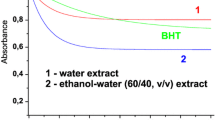Abstract
Polyphenolic composition (flavonoids and phenolic acids and aldehydes) is studied in the Et2O soluble fractions of the methanolic extracts ofEucalyptus camaldulensis, E. globulus andE. rudis bark. Gallic, protocatechuic, vanillic and ellagic acids, and protocatechuic aldehyde were identified in the three species; eriodictyol, quercetin and naringenin, inE. camaldulensis andE. globulus; vanillin, inE. camaldulensis andE. rudis; naringin, quercitrin, luteolin and kaempferol, inE. camaldulensis; taxifolin and apigenin, inE. globulus; and methyl benzoates and cinnamates, inE. rudis. Some unidentified ellagitannins, flavonols and flavanones were also detected. Significant differences in composition among species were found:E. rudis showed the lowest concentration in flavonoids andE. globulus presented higher concentration and variety of ellagitannins than the others.
Zusammenfassung
Die in Ethylether und Methanol löslichen Extrakte der Rinde von drei Eukalyptusarten wurde hinsichtlich ihre Polyphenolanteile untersucht (Flavanoide, phenolische Säuren und Aldehyde). In allen drei Arten wurden Gallussäure, Protocatechusäure, Vanillinsäure und Ellagsäure identifiziert. Eriodictyol, Quercitin und Naringenin fanden sich inE. camaldulensis undE. globulus, Vanillin inE. camaldulensis undE. rudis. Naringin, Quercitrin, Luteolin und Kampher wurden inE. camaldulensis identifiziert, Taxifolin und Apigenin inE. globulus. Benzoate und Cinnamate wurden inE. rudis entdeckt. Weiterhin wurden einige noch nicht identifizierte Ellagitannine, Flavanole und Flavanone gefunden. Charakteristische Unterschiede zwischen den Arten ware folgende:E. rudis zeigt die niedrigste Konzentration an Flavonoiden;E. globulus weist höhere Konzentrationen und größere Variationen der Ellagitannine auf.
Similar content being viewed by others
References
Conde, E.;Cadahía, E.;García-Vallejo, M. C. 1992: Optimization of TLC for the research on the flavonoids in wood and bark of the genusEucalyptus L’ Heritier. Chromatographia 33 (9/10): 418–426
Gell, R. J.;Pinkey, J. T.;Ritchie, E. 1958: Constituents of the kino ofE. maculata. Aust. J. Chem. 11: 372–375
Mishra, C. J.;Misra, K. 1980: Chemical examination of the stem bark ofE. maculata. Planta Medica 38 (2): 69–173
Sharma, P. J.;Crowden, R. K. 1974: Anthocyanins in someEucalyptus species. Aust. J. Bot. 22 (3): 623–627
Singleton, V. L.;Rossi, J. A. 1965: Colorimetry of total phenolics with phosphomolybdic-phosphotungstic acid reagents. Am. J. Enol. Vitic. 16: 144–158
Yazaki, Y.;Hillis, W. E. 1976: Polyphenols ofEucalyptus globulus, E. regnans andE. deglupta. Phytochem. 15 (7): 1180–1182
Author information
Authors and Affiliations
Rights and permissions
About this article
Cite this article
Conde, E., Cadahia, E., Diez-Barra, R. et al. Polyphenolic composition of bark extracts fromEucalyptus camaldulensis, E. globulus andE. rudis . Holz als Roh-und Werkstoff 54, 175–181 (1996). https://doi.org/10.1007/s001070050162
Issue Date:
DOI: https://doi.org/10.1007/s001070050162



